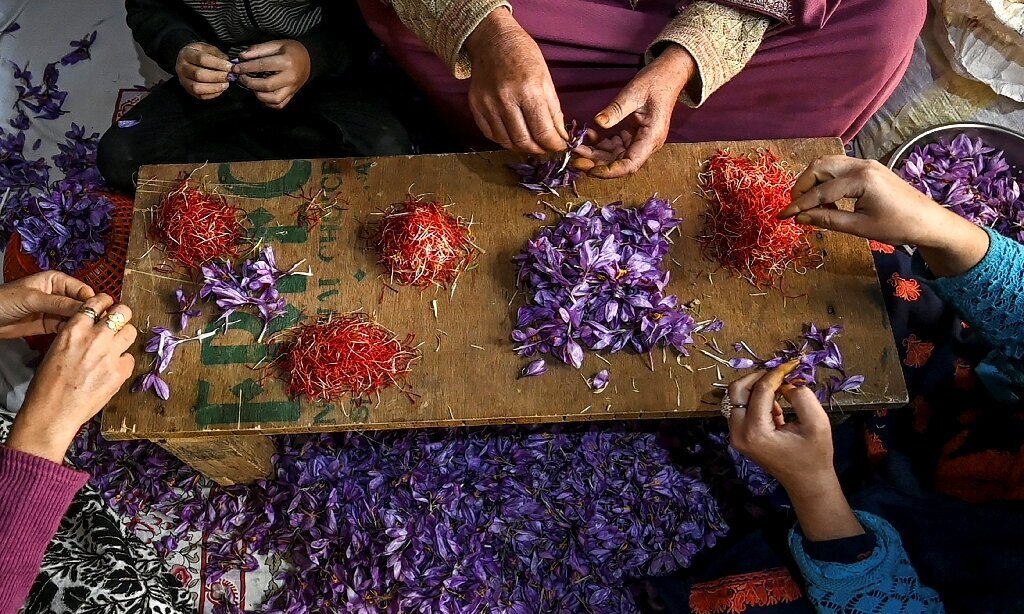Kashmir’s saffron cultivation threatened by global warming
 Srinagar: Kashmir’s saffron cultivation, a symbol of heritage and vital source of income for local farmers, is grappling with sustainability and livelihood issues. Rising global temperatures, erratic weather patterns, unseasonable warmth, and diminishing snowfall disrupt the delicate balance required for saffron cultivation.
Srinagar: Kashmir’s saffron cultivation, a symbol of heritage and vital source of income for local farmers, is grappling with sustainability and livelihood issues. Rising global temperatures, erratic weather patterns, unseasonable warmth, and diminishing snowfall disrupt the delicate balance required for saffron cultivation.
The Kashmir Media Service reported that the farmers who have invested their lives in this aromatic harvest are now facing uncertainty and declining yields, jeopardizing their livelihoods and the cultural legacy of saffron production.
Saffron production, which once reached nearly 17 tons annually, has now stabilized at around 15 tons. However, the technology and research being done by the Advanced Research Centre for Saffron and Seed Spices in Pampore area of Pulwama district, the only saffron research centre in Indian illegally occupied Jammu and Kashmir (IIOJK), that is continuously engaged in increasing the production of the crop.
“Due to changing weather patterns, the research centre has developed an irrigation schedule for saffron farmers. This schedule, detailing when and how much irrigation the crop requires, has been shared with the Department of Agriculture. The research centre has provided comprehensive guidance covering all aspects of saffron cultivation, from land preparation and seed sowing to intercultural operations, harvesting, and post-harvest management, which is now accessible to our farmers,” Bashir Ahmad Ilahi, Professor and Head, Saffron Research Station, Pampore, said.
He said that saffron seeds are ideally sown in late July, with the crucial condition that the soil remains moist but not waterlogged. “The flowers typically begin to bloom between October 10 and 15, and harvesting occurs regularly by November 15. Once sown, the saffron crop can yield new produce for the next 4 to 5 years,” Ilahi said.
This delicate spice, revered for its rich flavor and vibrant color, flourishes in the unique climate of the region, cultivated across 3,500 hectares by generations of dedicated growers.
Abdul Majeed Wani, a saffron grower, said his family has been engaged in saffron farming for decades, particularly in the Pampore area of Kashmir.
“Unfortunately, saffron production has declined in recent years. While India’s demand for saffron reaches nearly 50 tons, we only produce about 10 to 12 tons. To support saffron farmers, the Indian government established a Saffron Park in Pampore in 2014, which became operational in 2020. Over 500 farmers bring their harvests here for testing, drying, and marketing. The facility also provides a Geographical Indication (GI) tag, which helps prevent adulteration and ensures the quality of our saffron,” Wani said.
Wani said that the world’s best saffron is produced in Pampore, where prices range from 1.10 lakh to 1.25 lakh per kg.
“Since the establishment of the Saffron Park, we have been able to sell saffron for as much as 2.50 lakh per kilogram. Pampore stands as the major hub for saffron farming in the region.
“Global warming has contributed to a decline in saffron crops, with untimely rainfall adversely affecting production. Fortunately, last year saw timely rainfall, allowing the crop to recover to previous levels. This year, the rain has arrived on time once again, and we remain hopeful that the crop will be plentiful,” he added.
With each passing season, the once-reliable rhythms of nature become increasingly unpredictable, casting a shadow over the vibrant fields that have thrived for centuries. The implications extend beyond agriculture; they touch the heart of the community, threatening not only economic stability but also the deep-rooted traditions that bind the farmers to their land.









